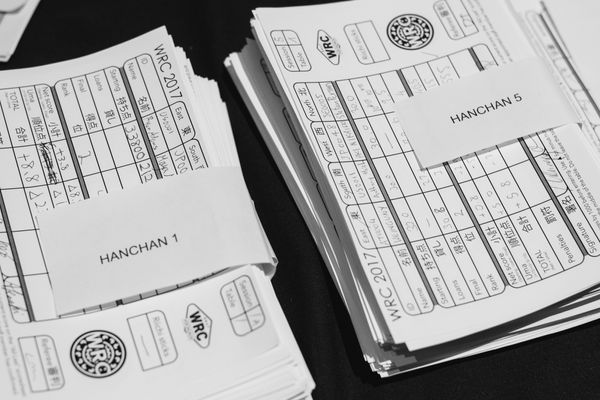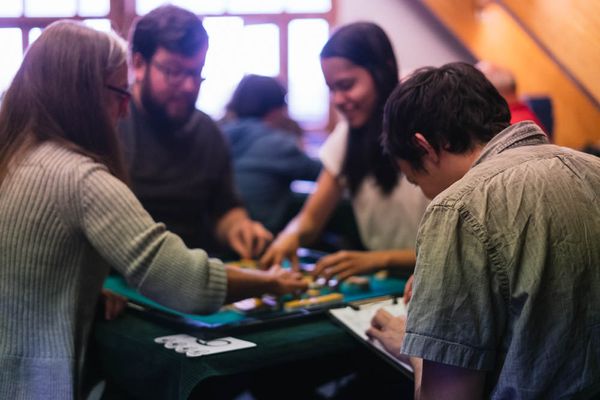Osamuko.com Observer Report (WRC2014)
There has been a bit of a tradition in Europe to have someone write a report on what they observed in Mahjong tournaments in order to give an indication of what worked, what didn’t, and what needs to be improved in future tournaments. Here’s our Osamuko.com version, unexpurgated, for your viewing pleasure.
Event: WRC2014 (1st World Riichi Mahjong Championship)
Date: July 16-20, 2014.
Place: Puteaux, France (92800)
Location: Puteaux City Hall
Registration Fee: 200 euros
Website and other sources of information: www.wrc2014.com as well as occasional posts on osamuko.com, reachmahjong.com, mahjongnews.com, mahjong-europe.com (EMA) and most of the European associations (DMJL, FFMJ, UKMA, NMB, etc.). Word of mouth was also prevalent among some organizations, both verbally and over the internet.
— There were various people saying there was not enough information (from France, Hong Kong, …) but given the type of event and the limited entry berths (as well as the distribution mechanisms), the organizing team did the best they could, with a few minor oversights.
Participants: 120 from 23 countries. 45 were from Japan (38 JPML + 5 NPM Kyoukai + 2 Saikouisen), 9 from USA, other countries got 7 or less. (All EMA countries except Portugal, Hungary and Belgium (16), plus Australia, Canada, China, Singapore, South Korea). — The number was appropriate for the size of the venue, but future needs will require more. One player did not make it to the event. The selection processes were also asymmetric in use and application.
Playing Schedule: 14 hanchan of 90 minutes (4-4-4-2), no games on Wednesday the 16th, with only Sunday being on an earlier schedule. The final had two extra matches.
— The schedule was fine for a manually shuffled tournament. The final matches could/should have had a better broadcast relay for people to watch. Some people played on social tables as a substitute for not being able to follow the final accurately.
Location: Puteaux City Hall (131, rue de la République, Puteaux 92800). The venue was big and spacious but there were two significant issues: three toilets shared amongst both genders (hanchan breaks often had lineups), and an oppressing heat given an outdoor heat wave, and the necessity to leave the windows open (or we would fry from sunlight).
— Air conditioning is most likely a requirement for all future events of this size, despite the rarity of air conditioning across Europe. People were literally (ok, figuratively) melting in their seats, tables had to be occasionally moved to get out of the sun.
Equipment: 30 Junk Mats for uniform table surfaces, three different types of mahjong tiles, legibility was fine, most looked the same with no significant differences between types, some had dora/shuugi gemmed tiles (haku-pocchi, gemmed threes, akadora). Table 25 had its first hanchan start with 5 3-man tiles and 3 2-man tiles. There were two autodealers present, used only for the final and as a backup in case there was a mechanical issue with the first table used.
— Sufficient for this event, expectations might go up for future events.
Referees: 7 total. Their roles were to ensure that tables could play continuously and fairly. One role they had was to distribute and mark debt counters (10 000 points or more as needed) as well as player chombo penalties. Sometimes, they had to enforce rules on players regarding dead hands.
— The referees did their jobs to the best of their abilities. There were two issues: some saying there were too few referees (although to be fair, what is the ideal number or ratio? We at Osamuko.com believe that 7 was sufficient. Some referees thought much less was needed, including the answer “1”.) and some refereeing lacked burden of proof tests. Many games let the occasional dead wall flip slide, some games had players playing the rulebook as opposed to the game, to the point where there was an imbroglio on one table where a dead hand was assigned before the deal was completed then the deal was considered void after multiple players took and saw 16 tiles. The penalties for the major cock-ups were sufficient (chombos, dropping tiles from an opponent’s hand), the dead wall “sacredness” was deemed both by thoughts and by actions of the majority to be superfluous and an unnecessary intrusion to the flow of the game (insert rambling about ill-thought MCR rules and practices affecting riichi), as live tiles from the wall have much more impact than dead wall tiles. Even picking and playing the wrong tile was allowed to be gracefully corrected with no malice from the Japanese professional community. Self-governance and tolerance were present for most and absent for a few. There was also a grand push to rewrite the whole enforcement of the rules with article 1 stating “Don’t be a dick.”, as mentioned by multiple people of multiple nationalities. As an aside, there were referee cards that existed for referees to clearly communicate intent to all players at tables, but were not used or needed, namely a card labeled “LEGIT 合法”.
Event Complaints: As mentioned already…
- Heat
- Rule jockeying — Both some players turning sour, and apparently the big issue regarding the “3 second rule”.
- Food (The quality of the food was excellent, but the variety was not sufficient for an international event. We get that French people are proud of French cuisine, and for most things, rightfully so. But with various allergies, intolerances, and lack of labeling, some people were restricted to eating leftover croissants and dessert, and there were unconfirmed reports of people bringing in their own food (burgers and onigiri).)
- Slow score updating. It was sufficiently fast for a paper-and-printer setup, but it is fair to say that more was expected out of a world-class event. There was also an issue with letting an amateur photographer (cough) take a picture to “protect an exclusive”… which was apparently already promptly leaked to the internet by someone else in Japanese.
- The clock went out at least twice due to the projector going down or the computer system crashing. However, It did not appear as if any time was lost in the rounds.
- The registration process took way too long: while drawing was a small thing, there were a bunch of small things multiplied 120 times that made the queue last for well over an hour.
Information and Communication during the event: There were a few instances of garbled speech that were unneccesary and others that could be avoided. There were some eyes rolling at the quality of some passages in both English and Japanese. There was a live translation offered by Jenn Barr, which turned out to be both vital and effective.
Draw and table assignments: The method seemed fair enough, the seeding of country pools could have been communicated in advance (they do it for the FIFA World Cup…), players rotated in a cyclic fashion (no real name for it, people were calling it erroneously a round-robin) where players {w,x,y,z} were placed at table {w mod 30,x mod 30,y mod 30,z mod 30} and kept rotating by {+0,+1,+2,+3} continuously. This method has flaws for certain numbers of people, but as the preliminary round had 8 hanchan for 120 people, there was no conflict. There was also some people talking about how the first 30 Japanese players got to stay at the same table. While no one made any accusations of ganpai, there were some sets that were clearly over-used. Given the rarity of quality play sets, and to minimize risks, future events should rotate all players by {+1,+2,+3,+4} instead.
Evaluation of playing sessions:
- The schedule was easy to define and easily available to all players in a reasonable timeframe. There were communication errors that led to some tables playing with the wrong wind assignments, as many Japanese have never heard the words “East, South, West and North” or the abbreviations of ESWN before. One pro was filmed having marked E = 東 (and the others) on her arm. Ideally, the information on that sheet should also have been bilingual.
- The quality of the Japanese players was amazing. The quality of most non-Japanese players was also very high. Some were probably lacking experience in high-stakes playing of the sort, some were playing with strategies that were not working well against both the professional and amateur players at this type of event. A few seemed unable to count points at all or play for a position. There were some people playing with foreign objects on the table.
- Playing with sticks was divine providence for this tournament. Having to record a score after every hand in a ledger is a horrible timesink in the current format of the EMA-approved tournaments. Very few games were terminated due to the clock, and of those, most were in South 4. The score sheet was compact, concise, it had one factual error due to placing the debt line below the uma but was otherwise good. If a tournament score appeared to be erroneous, the staff corrected it without trying to back-talk the players (to be fair, it was their mistake in the case I was made aware of).
- Communicating scores in-game varied given the proficiency of players with either English or Japanese, along with the back-and-forth of making a counting error and understanding the correction. The lowest common denominator seemed to be counting out the scores as single digits, as everyone, including Japanese pros with no English proficiency, knows the digits from zero to nine. “Five, eight, oh, oh” or “three, nine, zero, zero” seemed to sufficiently communicate the point to everyone. I would say that at least half of the non-Japanese players learned enough Japanese to communicate the score in Japanese.
— We hope this value approaches “90% to all” for the next WRC.
Catering: Breakfast and lunch were covered on game days, a light cocktail event was offered on the 16th, and a cake on the 20th. The complaints have already been made above regarding the variety.
Prizes: Top 10 (1st, 2nd, 3rd, 4th, ex aequo 5ths, 7ths, and 9ths), top female player (in this case 11th), top hanchan (went to one of the players in the better quarter of relegation). There were no booby prizes or “highest hand” as hands were not recorded individually (not to mention that playing bingo-style mahjong is not effective at all). While listing every name is long, we do want to mention that the 1st World Champion of Riichi Mahjong is Hiroshi Yamai. Congratulations!
Conclusion: Even with the few negative points (and the way they are highlighted seems a bit terse) that did occur, I believe that no one present regrets their experience. Maybe their result, but there are tons of those, myself included. I do not believe there is anyone out there that could have pulled off this event this well at this moment in time anywhere outside of Japan, and all kudos and heart-felt appreciation goes to TNT for organizing, the 7 referees (some were not from TNT), the JPML for participating in such a large number and their overture to the NPM Kyoukai and Saikouisen NPM to include some of their members, all other participants, the stakeholders, sponsors, and to all the fans who could not make it due to cost, timing, or the selection process. While the latter cannot let everyone in, we hope that the future will be able to select a broader cross-section of participants with maybe a larger emphasis on Mahjong results as opposed to solely considering affiliation. We also hope that people having contributed to the success of the event just past have a favorable appraisal with relation to participating in future events, in the United States and beyond.



